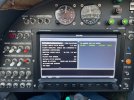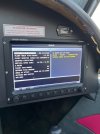jaredyates
Member
I thought I had just completed a Skyview installation with two screens and a primary and secondary ADAHRS. Everything was working great, I flew for an hour or so and completed the inflight compass calibration and AOA calibration. Then the next morning I started up to fly again, and after 30-60 seconds or so I get a red X on the PFD with "ADAHRS Fail Internal Error: Multiple Sensors". Ever since, that is all I can get it to do. All the while, the network configuration works perfectly and there are no other errors.
I put in a ticket with support and they say check the wiring. I inspected the wiring visually, no problems. I removed a known-good network cable from between the right screen and the com head and connected directly from the left screen to the primary ADAHRS, and no change. This is with the wires temporarily routed to ensure I can see the whole thing- there are no kinks or strain anywhere. It seems to me that this rules out any wiring problems, but honestly I would have rather found a wiring problem.
How can the primary and secondary units both fail, with no explanation from the system (or support, after I sent them the diagnostic file) about how or why or even what has failed? All the support tech said was that all of the sensors failed. Every sensor in the box, for both boxes? Did I get struck by lightning? What if this had happened some place other than home, or on the ground? Can the system really be that fragile and non-reporting?
What can I be missing here, and how can I get more information out of the system or anybody else about what is actually happening and what I should do to fix it? It seems extremely improbable that both ADAHRS units have failed, and if the next step is to send them in, that means a couple of hours of work, a couple of weeks of down time, and a likely diagnosis that everything is fine on a factory bench test?
I'd welcome any ideas about navigating out of this frustrating situation.
Pics of the screens: https://photos.app.goo.gl/HzgYpHhDZGusYiUEA
I put in a ticket with support and they say check the wiring. I inspected the wiring visually, no problems. I removed a known-good network cable from between the right screen and the com head and connected directly from the left screen to the primary ADAHRS, and no change. This is with the wires temporarily routed to ensure I can see the whole thing- there are no kinks or strain anywhere. It seems to me that this rules out any wiring problems, but honestly I would have rather found a wiring problem.
How can the primary and secondary units both fail, with no explanation from the system (or support, after I sent them the diagnostic file) about how or why or even what has failed? All the support tech said was that all of the sensors failed. Every sensor in the box, for both boxes? Did I get struck by lightning? What if this had happened some place other than home, or on the ground? Can the system really be that fragile and non-reporting?
What can I be missing here, and how can I get more information out of the system or anybody else about what is actually happening and what I should do to fix it? It seems extremely improbable that both ADAHRS units have failed, and if the next step is to send them in, that means a couple of hours of work, a couple of weeks of down time, and a likely diagnosis that everything is fine on a factory bench test?
I'd welcome any ideas about navigating out of this frustrating situation.
Pics of the screens: https://photos.app.goo.gl/HzgYpHhDZGusYiUEA


